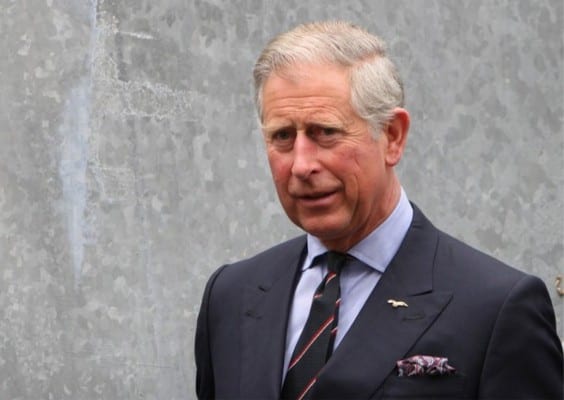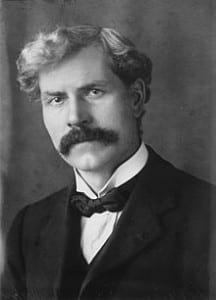Michael Faulkner
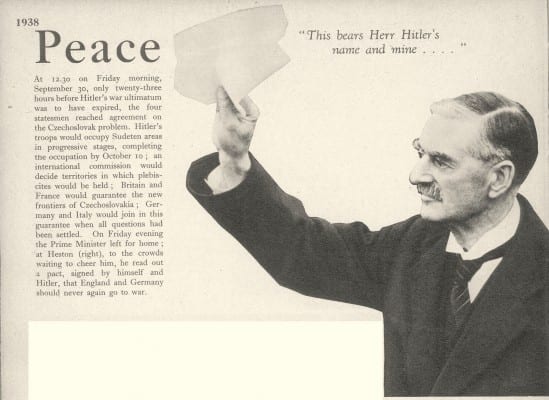
[dropcap]O[/dropcap]ne of the most sedulously cultivated myths about the monarchy in Britain is that it is neutral and stands above politics. In Walter Bagehot’s phrase the monarch is supposedly the dignified servant of parliamentary democracy. All the powers earlier accruing to its feudal and post-feudal despotic representatives, have been whittled away through centuries of evolving democratization to the point reached sometime in the nineteenth century where no real political power or influence in governance was left at all. That is the claim that needs to be scrutinized.
On the 26th March two news stories broke reflecting the widespread British fascination with royalty. Thousands of people in Leicester lined the streets, many in a mood of solemn obeisance, as the bones of Richard III, discovered last year beneath a parking lot in the city after lying buried for 530 years, passed in a funereal pageant accompanied by the Queen’s Division and Royal Signals bands, to be re-interred in Leicester cathedral. The last Plantagenet king was killed at the Battle of Bosworth which brought to an end the Wars of the Roses in 1485. He had seized the throne by acts of ruthless chicanery, including infanticide, extreme even by the blood-soaked standards of Britain’s medieval monarchs.(1) But thousands of onlookers, many tearfully displaying white roses, knew or cared little about this. Seemingly enchanted by the myth of royal bloodline, they displayed what Guardian columnist Polly Toynbee described as “a feudal state of mind from which we have never quite escaped.” The second story is more prosaic.

More than 35,000 people line the streets of Leicester to mark the final journey of King Richard III. Many grip white roses, ready to throw at the coffin as it passes. (2)
[dropcap]F[/dropcap]or ten years The Guardian newspaper has been trying under the Freedom of Information Act to have released to the public letters written secretly to government ministers by Prince Charles.
The Prince of Wales is heir apparent to the throne. He is strongly opinionated and makes little attempt to conceal his views on a wide range of matters, many with a potential bearing on government policy. He has very conservative architectural tastes and is a forceful advocate of homeopathic medicine, the availability of which he wants to see extended within the NHS. Scientists have accused him of promoting ‘mumbo-jumbo’ and ‘quackery.’ After a long legal battle during which the government opposed publication at every stage, the attorney general, Dominic Grieve, vetoed a decision by the High Court in favour of publication. Eventually the case came before the Supreme Court which ruled in March that the attorney general’s veto had been unlawful. The letters can now be published, albeit with redactions. Of interest in this case is the view expressed by [now former] attorney general, Grieve, that it is better to pretend that Charles is impartial than to prove that he is not. That statement speaks for itself about the supposed neutrality of the monarchy.
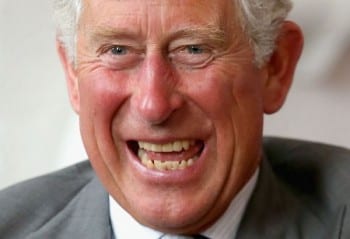 It cannot fail to strike anyone seriously interested in working for radical change in Britain – change that goes beyond the social democratic reforms that were, until they were torn apart by the depredations of neo-liberal capitalism in the 1980s, naively supposed to be irreversible – that so little serious attention has been paid by the radical left to the power and influence of the monarchy. It is as though the enchantment with monarchy has seeped into the soul of so many otherwise sensible people that they are hardly capable of looking at the institution rationally. Even some of those who express indifference, or even claim to favour disestablishment, seem squeamish about making a serious commitment to republicanism part of their vision for a transformed Britain.
It cannot fail to strike anyone seriously interested in working for radical change in Britain – change that goes beyond the social democratic reforms that were, until they were torn apart by the depredations of neo-liberal capitalism in the 1980s, naively supposed to be irreversible – that so little serious attention has been paid by the radical left to the power and influence of the monarchy. It is as though the enchantment with monarchy has seeped into the soul of so many otherwise sensible people that they are hardly capable of looking at the institution rationally. Even some of those who express indifference, or even claim to favour disestablishment, seem squeamish about making a serious commitment to republicanism part of their vision for a transformed Britain.
[dropcap]T[/dropcap]he mystique with which the monarchy has been endowed in Britain for more than a century and a half has had a corrosive effect on civil society, inhibiting the development of a sense of citizenship in a mature democracy. The antiquated ritual, the myth of hereditary ancient lineage and unbroken continuity, the investment of glamour and celebrity status on unexceptional people due solely to accident of birth – all contribute to the perpetuation of an institution that above all else serves the crucial purpose of preserving a hierarchical class system. The very terminology of constitutional discourse is replete with the symbolism of grandeur and privilege redolent of a long-gone imperial age: the obligatory etiquette governing all references to the monarch and the monarchical system – ‘Her Majesty’, ‘Your Majesty’, ‘His Royal Highness’ , ‘Her Majesty’s subjects’, ‘Her majesty’s government’, and so on. Like bowing and curtseying in the presence of their majesties or royal highnesses, all are obligatory. These obsequious gestures are considered ‘proper’ and ‘natural’ observances and proprieties, but all are so internalized in the mentality of ‘Her Majesty’s loyal subjects’, that such degrading subservience is accepted eagerly by those privileged to be ushered into the monarch’s gracious presence.
None of this has affected the belief of the British establishment’s champions of constitutional monarchy that the existence in perpetuity of unelected heads of state, determined only by accident of birth in a royal bloodline, is consistent with democracy. The numbers of such court propagandists amongst the political commentariat are legion, as are the usually specious arguments they employ to justify their beguilement by an antiquated, semi-feudal institution. For ninety years, since its first spell in government, the parliamentary Labour party has also been in thrall to the monarchic mystique and all the medieval mumbo- jumbo that corrodes the constitutional system in Britain. But the role of the monarchy as an active force in support of the ruling class in modern British politics has been evident from the early twentieth century to the present day. Three important interventions, each at critical junctures in British history, by three different monarchs, will suffice to make the point.
1931: George V, The Labour Government and the Economic Crisis
[dropcap]I[/dropcap]n 1929 a minority labour government took office led by J. Ramsay MacDonald with Liberal support. By 1931 it faced an economic and political crisis. The Tories then in opposition, the Liberals and right wing Labour ministers, including MacDonald, sought to deal with the slump which followed the 1929 Crash by imposing severe austerity on the working class. Unemployment stood at close to 3 million. The May Committee, set up by the government to seek ways of reducing national expenditure, recommended the harshest of measures, falling disproportionately on the workers and the unemployed, including a 20% cut in unemployment benefits. Such cuts were also made the condition of a U.S. loan sought by the government. The Tory opposition, the Liberals and the Treasury strongly favoured the cuts being implemented by a Labour government, but MacDonald was unable to get this past the Cabinet due to opposition from some Labour ministers. He intended to follow the accepted constitutional procedure, which meant that the government would resign and there would have to be a new election. But this was a course that the Tory/Liberal opposition wanted to avoid at all costs for fear of the widespread working class unrest that would ensue if an alternative Tory-led government tried to push through the cuts. Liberal and Tory leaders, Samuel and Baldwin, made their views known to King George V, emphasising that “in the national interest” MacDonald must remain Prime Minister. The King was, according to Ralph Miliband (Parliamentary Socialism.1961), “in all essentials a Conservative”, and “conservatism was to him synonymous with the ‘national interest’.” He didn’t need much persuading . The combined forces of the City, the Bank of England and the U.S. consortium led by J.P. Morgan heartily concurred with the proposal. The King, echoing the views of the political and financial elites, brought great pressure to bear on MacDonald, assuring him that ‘the nation’ would rally behind him even if his own party didn’t. MacDonald succumbed to the flattery and agreed not to resign but to lead a “national government” which would implement the cuts. The “National Government” – a Tory government in all but name and dominated by the Tories – lasted until the end of the decade of the “Hungry Thirties”. The Labour party was destroyed as a political force for many years. MacDonald resigned in 1935 and died in 1937, to be remembered on the Left only as a reviled renegade.
1938: George VI and the Munich Agreement
“I believe it is peace in our time…Go home and sleep quietly in your beds.” ——Neville Chamberlain. September 30. 1938
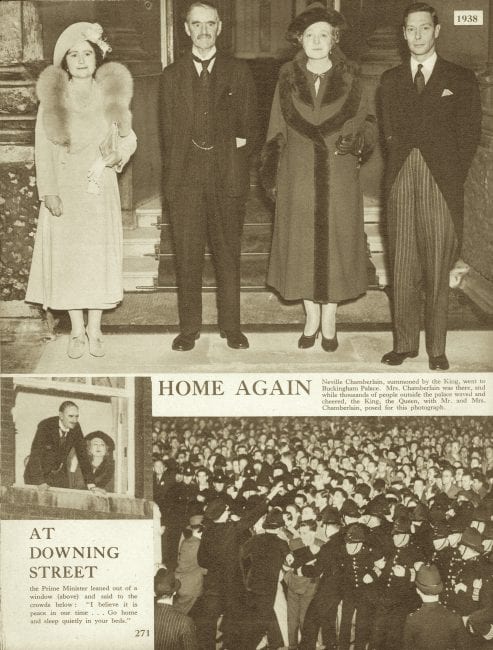
[dropcap]E[/dropcap]dward VIII, who abdicated in December 1936, is remembered as a sympathiser with Nazism. His sympathies in that direction extended beyond the outbreak of war in 1939. Less well-known is the attitude of his successor, George VI, towards the disastrous policy of appeasement pursued by Prime Minister Neville Chamberlain and his Cabinet, with the support of the Conservative party, from 1937 to 1940. Since the Second World War the Tories have lionised Winston Churchill, conveniently forgetting that they had sidelined him and confined him to the back-benches in the years leading up to the outbreak of war when he had pretty consistently warned against Hitler and opposed appeasement. Their hero was Neville Chamberlain. By 1938 public opposition to appeasement had grown steadily in Britain in favour of a policy of collective security with France, the Soviet Union and Czechoslovakia, to oppose Nazi aggression. Such a policy enjoyed widespread support from the Left and from Churchill and a minority of Tories. Chamberlain’s betrayal of Czechoslovakia at the Munich Conference in September 1938, to which the Russians and the Czechs themselves were not invited, resulted in the severing of the Sudetenland including the base of the Czech armaments industry, and the transfer of those territories to Germany. As all serious observers saw at the time, Czechoslovakia was crippled and left defenceless against the inevitable destruction of what remained of the state as soon as Hitler was ready. But Chamberlain returned from Munich on September 30th to the cheers of his relieved and gullible admirers who were persuaded by the majority of the Tory-supporting press that he had achieved “peace in our time.” In fact, as soon became clear even to those who did not want to see what stared them in the face, the Munich Agreement had made the war which broke out a year later all but inevitable. Britain and France, ignoring their treaty obligations, had betrayed the only democracy remaining in Eastern Europe.
So rushed was Chamberlain’s flight to Munich that there had been no time for Parliament to discuss what might or might not be decided there. The correct constitutional procedure would have been for Chamberlain to return immediately to Westminster to seek parliamentary approval. He did no such thing. According to Lord Beaverbrook’s Daily Express the Prime Minister was “summoned by the King” to Buckingham Palace. The King and Queen made no secret of their full approval of what had transpired at Munich. Such was their Majesties’ enthusiasm for his capitulation to Hitler that they arranged for a group photograph of Chamberlain and his wife flanked by the King and Queen, to be taken at Buckingham palace. In the photograph the piece of paper bearing Hitler’s name and his may be seen protruding from the Prime Minister’s jacket pocket. (See above.)
2014: Elisabeth II and the Scottish Independence Referendum
“She purred down the line.” David Cameron’s comment to Michel Bloomberg on the Queen’s reaction to the outcome of the Scottish Independence referendum, September 2014.
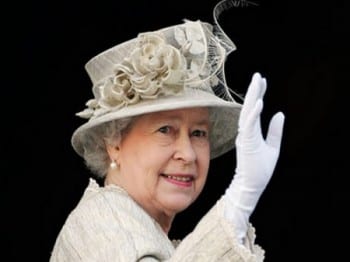 [dropcap]T[/dropcap]he referendum on Scottish independence of September 2014 was one of the most notable events in modern British history. Although the SNP inspired “Yes” campaign, in a 45%/55% division, failed to win, it developed a tremendous momentum in the weeks leading to the vote. It mobilized an astounding 84.5% of the electorate, far in excess of anything seen in U.K. elections since the introduction of universal suffrage in 1918. In some districts turnout topped 90%. The large numbers that turned out to vote, across the class and generational divide, clearly worried the Westminster elites who are never really happy with anything that resembles a mass political movement. But this is what the SNP is becoming. Astonishingly, despite losing the referendum, its membership has more than trebled since polling day and now stands at about 105,000.
[dropcap]T[/dropcap]he referendum on Scottish independence of September 2014 was one of the most notable events in modern British history. Although the SNP inspired “Yes” campaign, in a 45%/55% division, failed to win, it developed a tremendous momentum in the weeks leading to the vote. It mobilized an astounding 84.5% of the electorate, far in excess of anything seen in U.K. elections since the introduction of universal suffrage in 1918. In some districts turnout topped 90%. The large numbers that turned out to vote, across the class and generational divide, clearly worried the Westminster elites who are never really happy with anything that resembles a mass political movement. But this is what the SNP is becoming. Astonishingly, despite losing the referendum, its membership has more than trebled since polling day and now stands at about 105,000.
[dropcap]L[/dropcap]ittle has been said about the role of the Queen in the lead-up to the referendum. But she played a crucial role. Shortly before polling day one poll put the SNP’s campaign ahead of the “No” campaign. This produced panic in the three Westminster parties that were defending the union. Tory, Liberal and Labour leaders rushed across the border, terrified that the U.K might be on the point of break-up. We now know that there was a carefully prepared plan to involve the Queen, who, needless to say, shared their panic. Cameron, who had breakfasted with her and the Duke of Edinburgh at Balmoral conferred with the Cabinet Secretary, Sir Jeremy Heywood and the Queen’s private secretary, Sir Christopher Geidt about the best way to arrange for her to make a decisive intervention aimed at producing the “right” result in the referendum – that is, a majority against independence. Cameron’s own claim that a vote for independence would “break my heart” cut little ice with Scottish voters, but, if the Queen were to make her views known it would be a boon for the overwhelmingly anti-independence U.K. media who would seize on it with alacrity. Of course, everyone knew that the Queen must be horrified by the prospect of Scottish independence. The problem was how to get her to say something that seemed neutral but expressed deep foreboding – something that everyone would understand as an appeal to vote “No.” She must not be seen to overstep her constitutional role of supposed neutrality in political matters.
As she emerged from church at Balmoral a few days before Scotland was due to vote she followed her usual practice of shaking hands with one or two members of the discreet crowd of admirers who turn out to see her. A woman in the crowd (almost certainly planted) took the opportunity to ask her what she thought about the referendum. The Queen replied: “Well, I hope people will think very carefully about the future.” Strangely, the woman refused to give her name to the press, something very unusual if the question had been purely spontaneous. In fact the Queen’s words had been prepared very carefully by Heywood and Geidt, the two men sometimes considered to be at the centre of the “deep state” which exists to ensure that the monarch is not seen to cross the line of her constitutional duties. But her intervention nevertheless served the interests of the Westminster elites who, like her, are desperate to ensure that the “United Kingdom” does not fall apart.
Each of these three episodes occurred at critical moments in the history of the British state. In each case the monarch intervened decisively in a way that was clearly politically partisan and was intended to serve the interests of the ruling elites.
ABOUT THE AUTHOR
[box] Senior Contributing Editor Mike Faulkner is a British citizen. He lives in London where for many years he taught history and political science at Barnet College, until his retirement in 2002. He has written a two-weekly column, Letter from the UK, for TPJ Magazine since 2008. Over the years his articles have appeared in such publications as Marxism Today, Monthly Review and China Now. He is a regular visitor to the United States where he has friends and family in New York City. Contact Mike at mikefaulkner@greanvillepost.com [/box]
NOTES
(1) In late March (2015) Richard III was given a reburial at Leicester Cathedral, three years after his bones were found under a carpark in the city. The service might not have been attended by the current Queen, but there was one familiar relatives on hand to partake in the service – Benedict Cumberbatch.
Richard III died on August 22 1485 at the Battle of Bosworth, where he succumbed to the forces of the pretender to the throne Henry Tudor, but it’s taken 530 years for a proper royal burial. Yesterday the former king, who ruled for just three years before getting an arrow to the eye, or so history goes, was re-buried with all the pomp and ceremony you’d expect and making it a thoroughly modern affair, a token celebrity.
It’s estimated that as many as 17 million people can claim descent from Richard III, but one of the better known ones was invited to read a poem during the service. Benedict is closer than most in his descent from the monarch, according to science, which says he’s a cousin, 16 times removed.
(Source: entertainmentwise.com)
(2) Photo credits
(a) Photos of Prime Minister Chamberlain procured by the author.
(b) Images of Richard III’s reburial ceremonies from Richard III Reburial: Is England Honoring a Murderer?, by Rosella Lorenzi, Discovery News.
(c) All other images used under Creative Commons terms.
[printfriendly]



